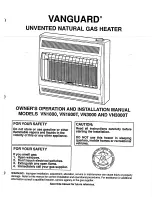
15
•
In rooms with high circulation intensity
•
In cellars and basements
•
In blocks of flats and multi-floor buildings
6.
Do not use the heater in dusty rooms or rooms with vapours of flammable liquids or gases.
7.
Do not switch the heater on in places where flammable substances are stored, e.g. petrol or other
flammable liquids and gases.
IV. GAS REQUIREMENTS
1.
This device must be used solely with the gas indicated on the rating plate (G30 37 mbar). This device
cannot be adapted for use with other gas types.
2.
The heater is designated for use with 11 kg gas cylinder. Internal dimensions of the housing
for the installation of the gas cylinder are (width) 37 cm x (height) 64.5 cm.
3.
The device requires a certified gas supply hose, at least 50 cm long, and a pressure-reducing valve with
the output pressure 37 mbar.
4.
The maximum adjustable input pressure must not exceed 37 mbar.
5.
The hose and gas pressure-reducing valve assembly must comply with the applicable standards
and local regulations.
6.
The installation must comply with local regulations and in their absence with the standards for storage
and handling of LPG.
7.
Indented, corroded or damaged gas cylinder may be hazardous and should be inspected by the gas
provider. Do not use a gas cylinder with damaged threaded connection between the gas cylinder, valve
or thread for installing the pressure-reducing valve.
8.
The flexible hose connecting the cylinder with the device via the pressure-reducing valve cannot
be twisted or exposed to contact with hot or sharp objects.
9.
Do not connect an unchecked gas cylinder to the heater.
10.
When the heater is not used, the cylinder must be disconnected.
V. FRESH AIR FOR COMBUSTION AND VENTILATION
PLEASE NOTE!
This heater needs fresh air supply to operate properly. Otherwise, gas may not burn as appropriate. To ensure
fresh air supply to this device and other fuel-burning devices in your house, please read the instructions below.
All rooms in houses belong to one of three categories with respect to ventilation:
1.
STANDARD AIRTIGHT STRUCTURE
Air getting inside by doors and windows can ensure sufficient quantity of fresh air for combustion and
ventilation. However, in buildings with above-standard airtight structure it is necessary to ensure additional
fresh air supply.
THE STANDARD AIRTIGHT STRUCTURE is defined as the structure where:
•
Walls and ceilings exposed to air from outside are equipped with vapour barrier
with the permeability ratio not exceeding 1 perm with sealed openings
and
•
Sealing tape was used for openable windows and doors
•
Seals and sealants are used in such places as joints round the door and window frames, between the
substructure and floor, between the walls and ceiling, between wall panels, in passages for systems,
electric and gas ducts and other.
2.
UNCONFINED SPACE
UNCONFINED SPACE ensuring at least 1.4 m
3
per 290 W of the total power output of all devices installed in it.
The rooms adjoining the space where the devices are installed, not equipped with doors, are considered
to be parts of the unconfined space.
3.
CONFINED SPACE
CONFINED SPACE ensuring less than 1.4 m3 per 290 W of the total power output of all devices installed in it.
To facilitate ventilation, open the door to the adjoining room. It is also possible to ensure additional
ventilation system.
















































